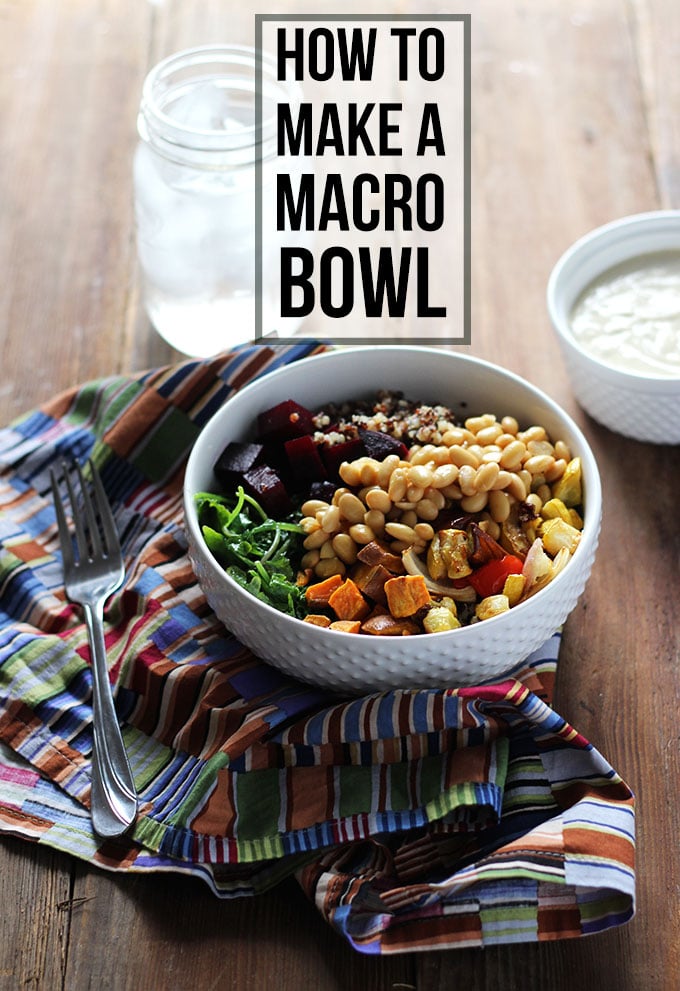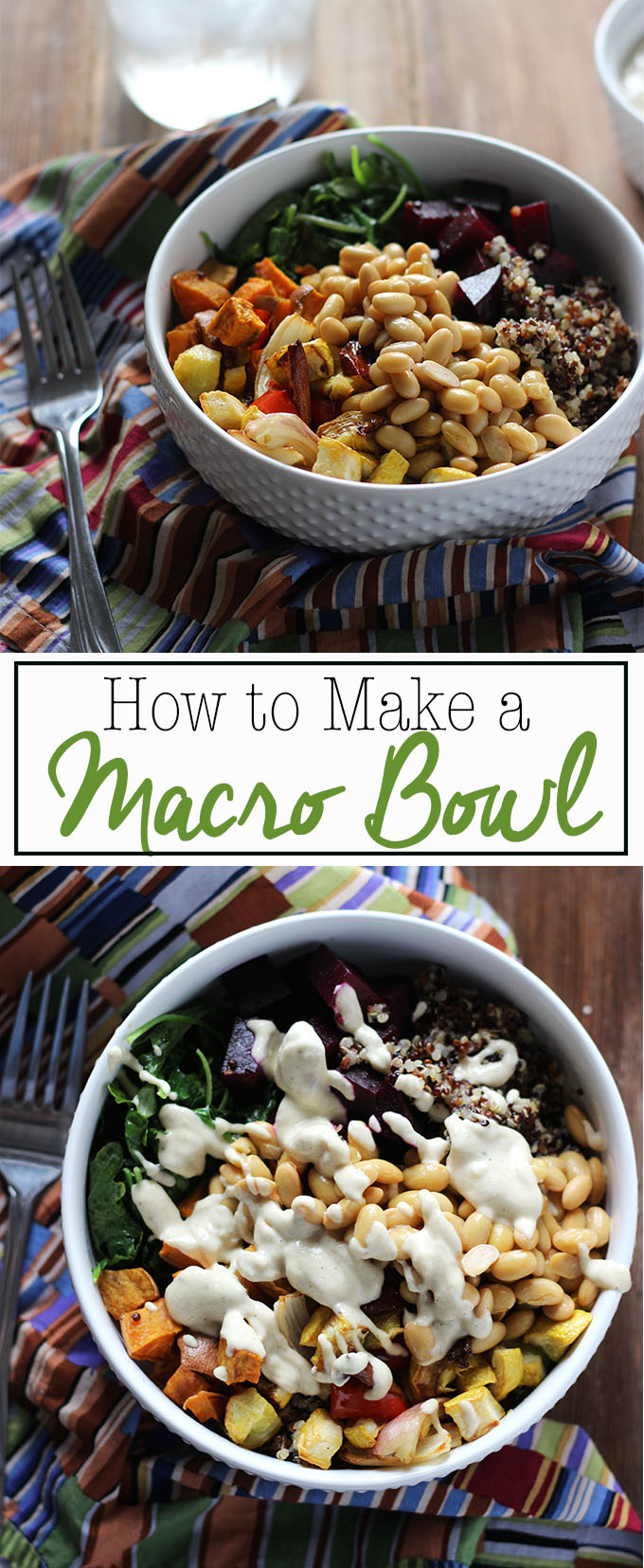 Have you ever heard of a macro bowl? You’ve likely spied the neatly arranged bowls of grains, vegetables, and protein on Instagram, but you may not have known they had a name. One of the reasons they are so popular is that the principles behind creating a macro bowl are easy to apply so that you can create healthy, balanced meals – bowl or no bowl!
Have you ever heard of a macro bowl? You’ve likely spied the neatly arranged bowls of grains, vegetables, and protein on Instagram, but you may not have known they had a name. One of the reasons they are so popular is that the principles behind creating a macro bowl are easy to apply so that you can create healthy, balanced meals – bowl or no bowl!
What is a Macro Bowl?
The popular macro bowl is loosely based in the principles of macrobiotics and the macrobiotic diet which became popular in the US in the 90s thanks to Madonna and Gwyneth Paltrow. The healthy eating philosophy was developed by George Ohsawa who wanted to apply the principles of yin and yang to diet to promote health and vitality. According to the macrobiotic diet, the ideal breakdown of your daily intake of foods should be: 60% grains, 30% vegetables, and 10% beans or tofu. These days, the concept of a macro bowl is based on “balancing your macros” or the 3 macronutrients: carbohydrates, protein, and fat. The formula for creating a macro bowl is pretty simple; whole grain + vegetables + protein + seasoning = healthy meal. 🙂 Using that formula, you can create a variety of healthy well-balanced meals by switching up the various building blocks for variety. Here are my tips on how to make a macro bowl at home.
5 Steps for Making a Healthy Macro Bowl
-
Choose a Whole Grain and/or Starch:
Grains give you a base upon which to build the rest of your bowl. Some good options include: brown rice, quinoa, farro, barley, buckwheat, lentils, or millet. Don’t go overboard on the grain though, try to fill no more than 1/4 of your bowl with whole grains or about 1/2 cup of cooked grains.
-
Pick Your Vegetables:
Make sure to add plenty of vegetables to your macro bowl! I usually like to add a mix of both cooked and raw vegetables to mine. To make assembling your bowl go faster during the week, prepping some of your vegetables over the weekend comes in handy. I like to roast up a big batch of veggies and save them in containers so that I can easily add them to a macro bowl anytime throughout the week. The type of veggies that I include depends on the season, but some of my favorites include: brussels sprouts, zucchini, sweet potatoes, bell pepper, red onion, carrots, cauliflower, peas, corn, green beans, beets etc. I usually do a combination of about 3-5 different vegetables (cooked and/or raw) in one bowl. Try to fill at least 1/2 of your bowl with vegetables and leafy greens or at least 2 servings of vegetables. A serving of vegetables is 1 cup of raw leafy vegetables (lettuce, spinach, kale) or 1/2 cup of other vegetables (cooked Brussels sprouts, roasted carrots, etc). Leafy greens are packed with good-for-you nutrients. You can either leave them raw or gently sauté them in some olive oil and garlic. Try these greens in your bowl: kale, spinach, swiss chard, cabbage, spring mix lettuce, arugula, etc.
-
Pick a Protein:
It is important to make sure you include some protein in your bowl. For vegetarians and vegans I recommend: tofu, tempeh, seitan, or beans. You can also chop up your favorite veggie burger or slice up a veggie sausage. When adding a plant-based protein, I try to get as close to 21 grams of protein (ie. a 3 oz serving of meat) as I can in one macro bowl. Protein is listed in grams on the nutrition facts label of the package. For example, the typical serving size listed on the package for tofu is 3 ounces or 1/2 cup, but that only has 9 grams of protein. So, I’ll sometimes eat 2 servings in my bowl to get closer to that 21 grams of protein goal. Of course, not all of the protein in your bowl will need to come from the beans/tofu as whole grains and vegetables also have provide a few grams of protein per serving. Need more protein tips? Check out my vegan protein guide!
-
Drizzle with a Condiment or Sauce:
Give your bowl a punch of flavor by adding a flavorful dressing or condiment. One of my favorites is tahini mixed with some water, lemon juice, mustard, salt and pepper. Other great options include: hummus, teriyaki sauce, soy sauce, sriracha, peanut sauce, curry yogurt sauce, or BBQ.
-
Optional Additions:
Give your gut some extra love by including some probiotic rich foods in your bowl like fermented pickles, olives, or kimchi. Nuts and seeds are also great for adding a bit more crunch as well as heart-healthy fats.
Here are a few examples of how to put together a macro bowl.
- Soba Noodles with Peanut Sauce: Grains aren’t the only whole grain/starch you can incorporate into a macro bowl! I used soba noodles for the base of this bowl and topped it with a variety of fresh vegetables, crispy tofu, and a homemade peanut sauce.
- Roasted Veggies with Curry Yogurt Sauce: Cooked quinoa serves as the grain base of this bowl that I then topped with roasted veggies, chickpeas and a drizzle of this curry yogurt sauce.
- Salad with Roasted Potatoes and Egg: Rather than a grain base, I used salad greens for this one and used roasted potatoes for the starch. This is a perfect example of a bowl I whipped up using some leftovers I had in the fridge. Macro bowls are a great for using up leftovers while still enjoying something healthy!
- BBQ Tempeh and Ranch Kale Bowl: If you haven’t tried tempeh before, I would make this recipe! It tastes great marinated in BBQ sauce. This bowl was simple to put together with some cooked quinoa, roasted sweet potatoes, kale, tempeh, and then a couple of pickled okra (for fun). Drizzle it all with your favorite ranch dressing and you have a well-balanced meal that wasn’t hard to put together.








Comments & Reviews
This is amazing inspiration, thank you. I want to make these! One question to get started: when prepping for the week, what are the veggie food safety rules that you abide by? What ingredients last for the full work week v. what should I plan to purchase more frequently/daily?
Thanks! For cooked veggies, you don’t want to keep them in the fridge for longer than 3-4 days. Since I get bored having the same thing for an entire week, I usually make these macro bowls for lunch for 3 days and then take salads or dinner leftovers the other 2 days of the week. We make a big batch of beans over the weekend and put them in smaller containers to store in the freezer. We use up each thawed container within three days and replace with a new one we pull from the freezer. That way our beans don’t go bad before we use them up! You could definitely do the same for other cooked foods if you are worried they will spoil before you use them. Raw veggies keep much longer so wait to cook them until needed if you can. Hope that helps!
YUM! I love making these!
I believe quinoa is a seed, not a grain.
True, it is a seed. Quinoa is just so commonly used as a grain, I usually just put it in that category when creating macro bowls.
Yes! I love throwing together Macro Bowls! So much great nutrition, real food, and taste in one wonderful bowl 😉
I love macro bowls! I make them about once a week, they are so good. I love the different combinations of veggies and dressing/sauces to switch up the flavors. Great guide!
Love this! I need to make these for lunch next week 🙂
Oh I could totally go for a good macro bowl right now! Love all of the ingredients in this one. Pinning!
I need to make one of these, they are the whole package!